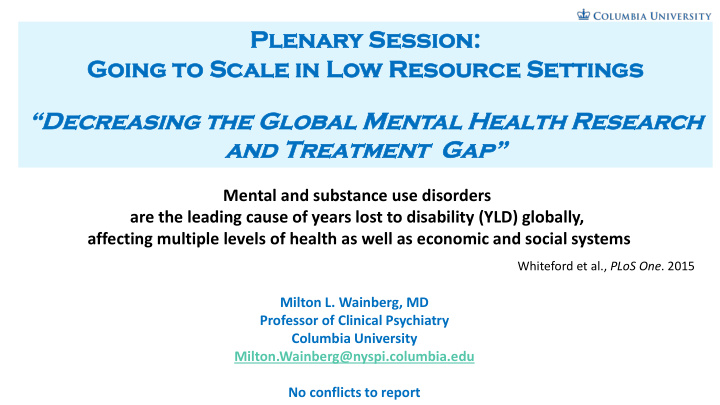



Plen enar ary y Ses essi sion: n: Goi oing ng to o Sc Scal ale e in in Low Res esour ource e Se Setting ings “Decreasing the Global Mental Health Research and Treatment an eatment Gap” Mental and substance use disorders are the leading cause of years lost to disability (YLD) globally, affecting multiple levels of health as well as economic and social systems Whiteford et al., PLoS One . 2015 Milton L. Wainberg, MD Professor of Clinical Psychiatry Columbia University Milton.Wainberg@nyspi.columbia.edu No conflicts to report
The Global The 10/90 Research Gap Mental Health Global Forum for Health : The Global Treatment Gap Less than 10% of worldwide resources Mental Health are spent in LMICs, where 90% of all Research Gap preventable death occur. Mental Health: 1:2 Million Only 6% of psychiatry journals content covers approximately 90% of the IDEAL: 45:100,000 world’s population Switzerland 39; USA 13; Mozambique 0.052 Prince, Lancet, 2007; Demyttenaere K et al, 2004; Wainberg ML et al, 2017 *
Research to Practice Gap 17 years for 14% of new discoveries to enter day-to-day clinical practice Longer for psycho/social/behavioral interventions Designed to be conducted by specialists, which works against dissemination LMICs: Lack of specialized human resources Mental Illness Stigma Minimal budget for mental health in most countries, especially in LMICs Green LW, et al, 2009; Brenner, R. et al. Ann Clin Psychiatry, 2010; Patel, V., Araya, R. et al. Lancet, 2007
Intervention Adaptation Development Model Wainberg, ML, et al, 2007 Fidelity to a particular intervention as developed and the need for local adaptation 2) Optimizing Fit: 1) Optimizing Fidelity to 1) Optimizing Fidelity: 2) Optimizing Fit: Contextual EBI Adaptation + the EBI: EB Principles Adaptation Principles EBI Principles Implementation Principles 3) Balancing Fidelity and Fit: 3) Balancing Fidelity and Fit: during scale-up EBI Implementation Strategy Intervention Adaptation 4) Pilot Testing and Refining: Final Intervention 4) Pilot of Implementation Strategy 5) Efficacy Testing: RCT 5) Hybrid Effectiveness- Implementation/ 6) Effectiveness, Implementation & Dissemination Dissemination Studies
Pamela Karen Johnson, Sara Scorza, PhD* PhD** (NYC: Davaasambuu, (PR: Homelessness PhD (Mongolia: Transgeneratio Syndemics) Adolescent nal Stress) (Faculty) Suicide) Advice to Early Career Investigators (UNICEF) T32 Sabrina Hermosilla, PhD** Train US new investigators to help build (Nepal: Child Liat Helpman, friendly spaces) Cady Carlson, a global mental health implementation PhD (Colombia: PhD (Uganda: Internally Schools MH) Displaced & science team NIMH – T32 MH096724 Trauma) Jennifer (Faculty) Columbia University Mootz, PhD* (Uganda: IPV Annika Kate & ETOH) Sweetland, Lovero, PhD* DrPH (Brazil: (Mozambique K Awardees & TB & MH) Academic Adolescent Girls *K under review Appointments HIV&MH) ** K in preparation
Global Partners: Fogarty/NIMH D43 (2014) & U19 (2017) GMH Hub 1. Botswana, 2. Malawi, 3. South Africa, 4. Zambia, and Partnerships Needed To Scale-up Effective 5. Mozambique PRIDE sSA: Interventions In Low-Resource Settings P artnerships in R esearch to I mplement and D isseminate 1. Angola, Sustainable and Scalable 2. Cape Verde, E vidence Based Practices in s ub 3. Guinea-Bissau, S aharan A frica 4. Mozambique , 5. Säo Tomé and U19 D43 Principe, and 6. Equatorial Guinea. IN EACH COUNTRY: MINISTRY OF HEALTH, UNIVERSITIES, NGOS
Hybrid E-I Cluster Pathway 1 – Usual Care: Randomized Trial: District Level Care: Psychiatric Technicians Three Pathways (Proctor’s Framework) Goal: Determine best “They were just a few – it was easy to supervise them. Priority Research Questions To Be Answered In cost-effective pathway to How do we grow, provide better access in rural areas, and still ensure expand comprehensive U19 – Research Capacity Building Component 29 mil illio lion in inhabit itants - 70% Rural Pathway 2 – Clinic Level Care: Support Of Scaling Up Interventions In Low- quality of care?” mental health care th poorest country 4 th ry CHWs* Screen, Refer to Clinic for Treatment (Measured Based-Care, resource Settings Lidia Gouveia, MD – MH Director/Mozambique Ministry of Health 13 Psychia iatri rists - 125 Psycholo logis ists - 0 PhDs in in MH Meds, IPT, MI) 250 Psychia iatric ic Technic icia ians (Task-Shif iftin ing) Screen: ~40,000 (G (Glo lobal* Mental Health Treatment Gap) Patients: ~14,000 Pathway 3 – Community & Clinic Level Care Providers: ~500 36 districts diverse both by CHWs & Clinic Providers *Global = low resources urbanicity *CHW: Community Health Workers (FIDELITY: Tablets – Measures/EBPs)
Thank you! Obrigado! Partners • Mozambique: Ministry of Health and their Providers; Patients, Relatives and Communities; U. Eduardo Mondlane & MIHER • Brazil: UNIFESP • US: Columbia, UPenn, Vanderbilt & Oregon Social Learning Center
Recommend
More recommend